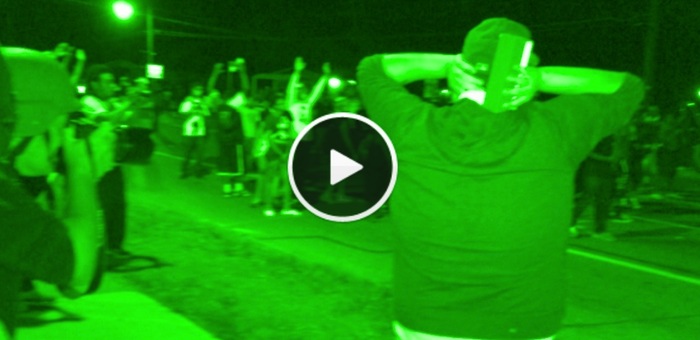Published August, 2014 by WITNESS in Uncategorized
Live From Ferguson: Videos, Detentions & Attempts at Defining the Press
“I was arrested for recording.” Those were the words of LaShell Eikerenkoetter last Thursday on the Instagram account she has used to share footage from Ferguson, Missouri, since the killing of unarmed black teenager Michael Brown on August 9. Officers “were pulling and yanking on a man with crutches,” she continued, explaining the scene she was filming when she was detained.
Anger over Brown’s killing and the militarized police response to protests have transformed Ferguson’s suburban streets into what looks like a conflict zone, and the front lines are filled with cameras, mobile phones, and social media feeds. Citizens like Eikerenkoetter, as well as local, national, and international correspondents, have provided real-time documentation the situation as it has unfolded over the past two weeks. Their footage has put a renewed spotlight on police tactics in the United States, and attracted attention from the likes of UN Secretary General Ban Ki-moon, the Committee to Protect Journalists, Amnesty International and Human Rights Watch.
Yet they have also attracted attention from local law enforcement. Video reports from a range of witnesses, activists, and media reveal not only a pattern of hostility and abuse of power exercised by authorities, but targeted reprisals for documenting police activities.
Targeting of Reporters
Eikerenkoetter was one of many peaceful citizens to be arrested in Ferguson in the past week. Her short videos include a clip of the footage she recorded at the time of her arrest (below), and details of the detention she describes as being about 18 hours long.
The same day Eikerenkoetter was arrested, reporters for two national news outlets were thrown in jail, even though they were away from the protests at the time of their detention. Wesley Lowery of the Washington Post and Ryan Reilly of the Huffington Post were working at a McDonald’s when police entered and ordered them out. Officers gave no explanation of the need to vacate the restaurant immediately. Lowery recorded a short video as he packed up his things to leave, but it ends before he was arrested while trying to exit.
“As I made my way toward the door,” Lowery recounts in his article the following day, “the officers gave me conflicting information. One instructed me to exit to my left. As I turned left, another officer emerged, blocking my path. ‘Go another way,’ he said.”
Like Eikerenkoetter, Lowery describes officers displaying brute force. He and Reilly, however, were released shortly thereafter.
St. Louis Alderman Antonio French, whose Twitter stream has provided a live account of events on the ground, was arrested Wednesday night. After fleeing from tear gas to the safety of his vehicle, he told KMOV, an officer opened his door, pulled him out, and took him into the station. French was released the following morning.
Many more reporters were arrested on Sunday while covering violent clashes in the streets after dark. The video below, a clip from Argus Radio’s live stream that night, captures the tense climate. As Mustafa Hussein filmed, an officer demanded he turn off the light he was using, issuing a threat if he dared not to.
Because the scene is dark, a fellow journalist recorded Hussein describe what happened. “The cop pointed the gun right at my face,” he says, “and told me, ‘Get the f**k out of here, or I will shoot you.’”
Who’s Media? And is that the Right Question to Ask?
When the local alderman, the barber, national correspondents reporting via Twitter in a McDonald’s, and everyone in between is providing real-time documentation on the ground, who is a journalist?
In Lowery’s account of his detention, that was the first thing officers asked. But showing a press ID didn’t prevent his arrest. The question came up again, however, when he and Reilly were in jail. “Who’s media?” the processing officer asked them. “We said we were. And the officer said we were both free to go,” Lowery wrote.
The local videographer and the alderman, also in jail that night after documenting the protests, were not afforded that privilege.
In a press conference this Tuesday, Highway Patrol Captain Ron Johnson explained the challenges law enforcement has had in maintaining peace and order. The blurred lines between “press” and others, he noted, is one reason reporters have been detained while covering Ferguson. In the midst of chaos, Johnson states, at 11:55 in the video below, “we’re not sure who’s a journalist and who’s not.”
“So yes, we may take some of you into custody,” he continues, “but when we do take you into custody, when we have found out that you are journalists, we have taken the proper actions.”
What, however, defines a journalist, and why should individuals filming events with press badge receive different treatment from those without such identification? The question is hotly debated in the journalism industry, especially when, as free press advocate Josh Stearns has noted, “anyone can carry a press in their pocket.”
Because of these changes in the way news is gathered and published today, Stearns has called upon the journalism community to “stop defining who is a journalist and protect all acts of journalism.”
Perhaps Ferguson authorities could overcome the challenge Johnson articulated if they, too, followed this call. They would protect—or at the very least not target individuals for committing—the act of journalism itself. That is the way that law enforcement is supposed to work—by defining individuals by their actions rather than their identities. After all, the anger expressed in Ferguson this month derives from the similar sense of injustice, that Michael Brown was killed not for a crime he committed, but because of who he was as an individual—a young black man.
For more citizen reports from Ferguson, follow the Human Rights Channel on Twitter, and check out this video playlist for the latest YouTube videos. If you are filming in Ferguson, click here for WITNESS resources on filming protests safely and effectively.
This article was written by Madeleine Bair and originally appeared on the WITNESS Blog. Charlotte Gilliland contributed research.
Lead Image: Screenshot from Argus Radio’s “I Am Mike Brown” Livestream channel.
This post was originally written for the Human Rights Channel, which is now the WITNESS Media Lab. Follow @WITNESS_Lab on Twitter for analysis and resources on the verification and contextualization of eyewitness video for human rights.

